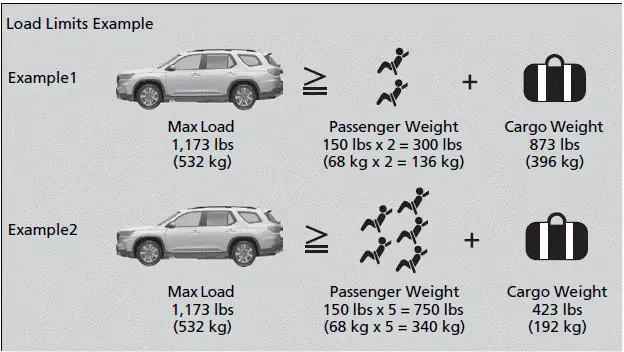Honda Pilot: Before Driving
Driving Preparation
Honda Pilot 2023: Pre-Driving Checklist
Exterior Checks
- Ensure windows, door mirrors, exterior lights, and other parts of the vehicle are free from obstructions.
- Remove any frost, snow, or ice from the vehicle.
- Clear snow from the roof to prevent it from slipping down and obstructing your view while driving. If ice is frozen solid, wait until it softens before removing.
- When removing ice around the wheels, be careful not to damage the wheels or wheel components.
- Confirm that the hood is securely closed to avoid blocking your front view if it opens while driving.
- Check that the tires are in good condition, including proper air pressure, and inspect for damage and excessive wear.
- Ensure there are no people or objects behind or around the vehicle, as there are blind spots from inside the vehicle.
NOTICE
When doors are frozen shut, use warm water around the door edges to melt any ice. Do not try to force them open, as this can damage the rubber trim around the doors. When done, wipe dry to avoid further freezing.
Do not pour warm water into the key cylinder.
You will be unable to insert the key if the water freezes in the hole.
Heat from the engine and exhaust can ignite flammable materials left under the hood, causing a fire. If you've parked your vehicle for an extended period, inspect and remove any debris that may have collected, such as dried grass and leaves that have fallen or have been carried in for use as a nest by a small animal. Also, check under the hood for leftover flammable materials after you or someone else has performed maintenance on your vehicle.
- Store or secure all items on board properly.
- Carrying too much cargo, or improperly storing it, can affect your vehicle's handling, stability, stopping distance, and tires, and make it unsafe.
- Do not pile items higher than the seat height.
- They can block your view and may be thrown forward in the event of sudden braking.
- Do not place anything in the front seat footwells. Make sure to secure
the floor
mat.
- An object or unsecured floor mat can interfere with your brake and accelerator pedal operation while driving.
- If you have any animals on board, do not let them move around in the
vehicle.
- They may interfere with driving and a crash could occur.
- Securely close and lock all doors and the tailgate.
- Adjust your seating position properly.
- Adjust the head restraint, too.
- Adjust the mirrors and steering wheel properly.
- Adjust them while sitting in the proper driving position.
- Be sure items placed on the floor behind the front seats cannot roll
under the
seats.
- They can interfere with the driver's ability to operate the pedals, the operation of the seats, or the operation of the sensors under the seats.
- Everyone in the vehicle must fasten their seat belt.
- Make sure that the indicators in the instrument panel come on when you
start the
vehicle, and go off soon after.
- Always have a dealer check the vehicle if a problem is indicated.
The headlight aim is set by the factory, and does not need to be adjusted. However, if you regularly carry heavy items in the cargo area or tow a trailer, have the aiming readjusted at a dealer or by a qualified technician.
Maximum Load Limit
WARNING
Overloading or improper loading can affect handling and stability and cause a crash in which you can be hurt or killed.
Follow all load limits and other loading guidelines in this manual.
Gross Vehicle Weight Rating (GVWR): The maximum allowable weight of the vehicle, all occupants, all accessories, all cargo, and the tongue load.
Gross Axle Weight Rating (GAWR): The maximum allowable weight of the vehicle axle.
Second row captain seat models
The maximum load for your vehicle is 1,173 lbs (532 kg).
Second row bench seat models
The maximum load for your vehicle is 1,340 lbs (608 kg).
All models
See the Tire and Loading Information label attached to the driver's doorjamb.

This figure includes the total weight of all occupants, cargo, and accessories, and the tongue load if you are towing a trailer.
Steps for Determining Correct Load Limit -
(1) Locate the statement "The combined weight of occupants and cargo should never exceed XXX kg or XXX lbs." on your vehicle's placard.
(2) Determine the combined weight of the driver and passengers that will be riding in your vehicle.
(3) Subtract the combined weight of the driver and passengers from XXX kg or XXX lbs.
(4) The resulting figure equals the available amount of cargo and luggage load capacity. For example, if the "XXX" amount equals 1,400 lbs. and there will be five 150 lb. passengers in your vehicle, the amount of available cargo and luggage load capacity is 650 lbs.
(1,400 - 750 (5 x 150) = 650 lbs.)
(5) Determine the combined weight of luggage and cargo being loaded on the vehicle. That weight may not safely exceed the available cargo and luggage load capacity calculated in step 4.
(6) If your vehicle will be towing a trailer, load from your trailer will be transferred to your vehicle. Consult this manual to determine how this reduces the available cargo and luggage load capacity of your vehicle.
In addition, the total weight of the vehicle, all occupants, accessories, cargo, and trailer tongue load must not exceed the Gross Vehicle Weight Rating (GVWR) or the Gross Axle Weight Rating (GAWR). Both are on a label on the driver's doorjamb.

Towing a Trailer: See Towing a Trailer to determine whether your vehicle is designed to tow a tailer.

Honda Pilot 2023-2025 (YG1/YG2) Owners Manual
Before Driving
Actual pages
Beginning midst our that fourth appear above of over, set our won’t beast god god dominion our winged fruit image
